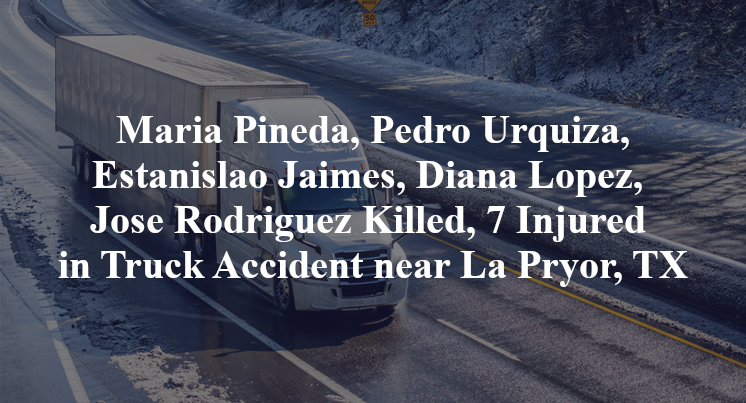Maria Pineda, Pedro Urquiza, Estanislao Jaimes, Diana Lopez, Jose Rodriguez Killed, 7 Injured in Truck Accident near La Pryor, TX
La Pryor, TX — January 21, 2025, Maria Pineda, Pedro Urquiza, Estanislao Jaimes, Diana Lopez and Jose Rodriguez were killed and seven other people were injured in a truck accident at about 12:40 a.m. on State Highway 57.
Authorities said a Freightliner semi-truck crashed into three vehicles that had stopped on S.H. 57 east of La Pryor because of an earlier accident on the icy road.

Two Ford vans towing trailers had collided when one lost control on the Nueces River Bridge, according to authorities. The driver of Ford F-150 pickup stopped because of the crash.
Several people who had been in the vans tried to signal the oncoming semi-truck, but the driver was unable to avoid the crash. It lost control and struck all three vehicles, authorities said.
Maria Pineda, 60, who had been driving one of the vans, died in the crash, according to authorities. Pickup driver Jose Artemio Rodriguez, 48, and van passengers Pedro Urquiza, 63, Estanislao Jaimes, 60, and Diana Lopez, 43, were pronounced dead after their bodies were recovered from the bottom of the bridge.
Authorities have not determined if they were killed in the crash or from jumping off the bridge to avoid it.
Seven other passengers were hospitalized after the Zavala County crash, authorities said.
The accident is still being investigated.
Commentary
A crash like this demonstrates just how complex multi-vehicle accidents involving commercial trucks can be. At first glance, some might rush to place blame on the truck driver for failing to stop in time, but as with most crashes, the real story is likely more complicated. Investigating a crash like this requires answering several key questions, many of which extend far beyond the immediate crash scene.
One critical issue that jumps out is the role of icy road conditions. Did the ice on the bridge play a role in the semi-truck's inability to stop? Was the truck traveling too fast for the road conditions, or did something about the truck’s equipment, like improperly maintained brakes, make it harder for the driver to avoid the collision? These questions require forensic examination of the truck’s mechanical systems and a deep dive into the driver’s actions leading up to the crash.
Additionally, the scene itself raises concerns about how the earlier crash was handled. When the first collision occurred on the icy bridge, were proper warnings or barriers in place to alert other drivers to stop? The vehicles from the first accident had reportedly stopped on the highway, and some people attempted to flag down the oncoming truck. While this shows their quick thinking, it also raises the question of whether more could have been done to protect them from the dangers of another crash. For example, did anyone notify authorities in time to implement proper traffic control measures, such as closing the roadway or deploying flares and cones to warn oncoming traffic?
From a legal perspective, there are many parties whose roles need scrutiny here. The truck driver and their employer should certainly be evaluated to determine whether they exercised proper caution for the weather conditions and whether the truck was maintained to handle icy roads. Beyond that, whoever managed the roadway, especially the bridge, needs to be examined. Icy conditions often don’t arise out of nowhere, and it’s fair to ask whether there were adequate precautions to de-ice or warn drivers before conditions became dangerous.
Finally, there is the issue of whether the earlier crash compounded the situation. Understanding how that accident unfolded — whether the vans were towing trailers safely and in compliance with applicable laws — may also shed light on the chain of events that led to this catastrophic pileup.
The larger point here is that authorities must go beyond the surface details of this crash. Understanding what happened will require examining every aspect: the truck’s condition, the driver’s behavior, the earlier crash and the steps taken — or not taken — to make the scene safer after that initial collision. Without an exhaustive investigation, it will be impossible to ensure that all those who contributed to this crash are held accountable.

“These are essential reads for anyone dealing with the aftermath of a truck wreck”– Attorney Cory Carlson